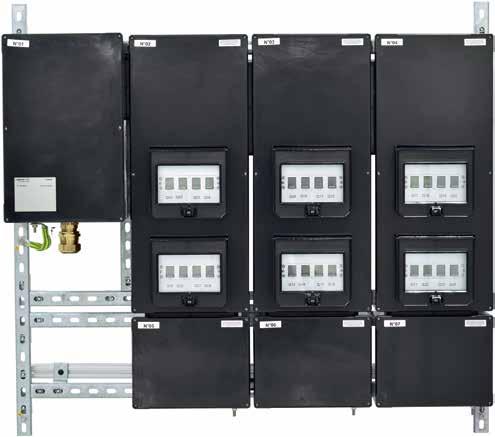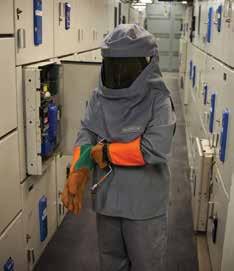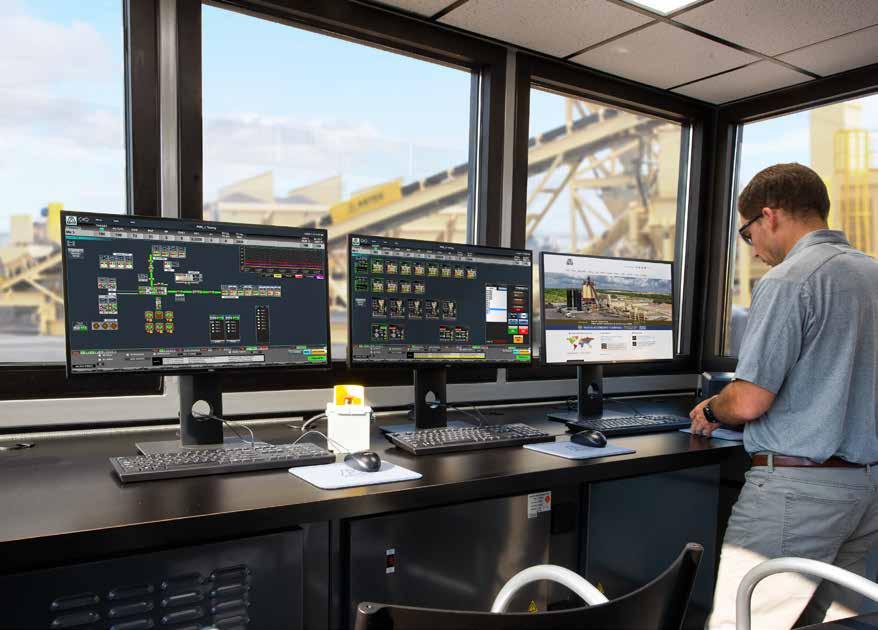
8 minute read
Arc Flash Safety: Create a Plan
Arc Flash Safety: Create a Plan for Compliance
AAccording to the National Fire Protection Agency (NFPA) 70E: Standard for Electrical Safety in the Workplace, arc flash is a “dangerous condition associated with the release of energy caused by an electrical arc.” In lay men’s terms, that translates into a sudden and dangerous blast of extreme heat, in tense light, and pressure waves that happens when a high-voltage gap exists between a phase bus bar and another phase bus bar, neutral or a ground.
Injuries are often devastating, as arc flash temperatures can reach 35,000° F, which is three times hotter than the sur face of the sun. An arc flash also can produce noise reaching 140 decibels—about as loud as a gunshot—and molten metal shrapnel.
Arc flash incidents can often be traced to human error or poorly maintained sys tems. Factors such as worn cable insulation, dirty or corroded contacts or electrical parts, a dropped tool, and occasionally an ill-fated rodent or bird, can all cause a catastrophic accident.
Some plant managers may justify their decision to not provide workers with arc rated, flame resistant (AR/FR) clothing or safety training by suggesting that arc flash incidents are so rare that it’s not worth the expense. However, a 2013 report pub lished in the May 31, 2013, edition of Industrial Safety & Hygiene News disputes that claim. It estimates that, on average, there are 30,000 arc flash incidents ev ery year in the United States or about 5-10 per day. The report went on to say that those incidents resulted in annual totals of 7,000 burn injuries, 2,000 hospitaliza tions, and 400 fatalities. Costs incurred by arc flash damage can reach millions of dollars in employee claims, insurance costs, equipment replacement and lost productivity.
Given the risk, frequency and sever ity of arc flash events, it is imperative that plants employ a host of mitigation This is an example of the Emerson Appleton Plexpower Fiber panel board. Photos courtesy of Emerson, St. Louis, Missouri.
processes to pave a safer path for work ers who maintain electrical distribution, power control and protection systems.
DRESS FOR DURESS
In April 2014, OSHA issued a final rule on electric power generation, transmission and distribution, and electrical protective equipment. Under the rule, employers must protect their workers from hazards posed by flames and electric arc in the fol lowing ways: • Identify employees who will be working around these hazards. • Estimate the incident heat energy of any electric-arc hazard to which a work er would be exposed at various points along the power chain. Accuracy is es
sential with such measurements, so plant managers who lack direct and ex tensive experience with arc flash incident energy assessment should always seek assistance from a qualified power systems engineer. • Ensure workers exposed to such haz ards wear protective clothing and other protective equipment with an arc rating equal to or greater than the estimated heat energy.
Wearing flame-resistant clothing can drastically improve the chance of walking away from an arc flash. Some of the dif ferent types of PPE that should be worn includes an arc flash suit, hardhat, leath er footwear, rubber gloves, arc-rated face shield and more. Workers should always

Example of arc flash suit

avoid wearing jewelry, including metal watches, metal fasteners on clothing, or any other conductive material.
In addition, only use tools, meters, and other equipment that are suitable for the voltage and current levels present when performing electrical work. Look for tools that meet IEC standards with an independent lab testing verifying it. The lab’s symbol on the tool means an indepen dent testing agency has checked the safety claims and CAT ratings.
SIX WAYS TO PREVENT ARC FLASH ACCIDENTS
As crucial as PPE is, it should be considered the last line of defense against arc flash. With the safety procedures outlined below, it’s possible to minimize the risk of arc flash.
1. De-energize equipment
The only way to completely eliminate hazards is to de-energize equipment. Be sure to test for the absence of voltage while wearing the appropriate PPE. Until the absence of voltage testing proves the circuits are dead, they must be consid ered energized. Note that OSHA doesn’t require that energy never be present; instead, it requires that the employer eliminate hazardous energy as the first option. If eliminating the hazard is not possible, only then can the employer consider reducing the risk to a tolerable level. Examples of when energized work is permitted include troubleshooting that requires voltage and when shutting down creates a greater hazard. OSHA does not permit energized work simply because it may be inconvenient or production-inhibiting to de-energize.
2. Maintain equipment
NFPA 70E Article 205.3, General Maintenance Requirements, states: “Electrical equipment shall be maintained in accor dance with the manufacturer’s instructions or industry consensus standards to reduce the risk of failure and the subse quent exposure of employees to electrical hazards.” This especially applies to break ers. If the breaker hasn’t been maintained and tested as required, there is no assur ance that it will respond in accordance with its published time-current curve. Many manufacturers recommend that breakers be removed from service and in spected at least once per year. Additionally, damaged insulation on high-voltage wiring and dust or other impurities accumulated on equipment can create a pathway for the flow of electricity and may possibly lead to an arc flash when high-voltage components are involved.
3. Don’t overstep your boundaries
The arc flash boundary is the minimum “safe” distance from exposed energized conductors or circuit parts that has the potential for an arc flash. NFPA 70E rec ommends defining three boundaries to minimize risk of electrical injuries. The outermost Flash Protection Boundary is set at a distance where, if a worker were exposed to an arc flash, they would sus tain a curable second-degree burn. The Limited Approach Boundary is set at a dis tance where a worker would experience a shock hazard. The Restricted Approach Boundary is set at a distance where a shock hazard is increased. The inner most Prohibited Approach Boundary is set at a distance so close to the energized equipment that it is considered the same as making contact with the live part. De pending on the piece of equipment being worked on, these boundaries will fluctu ate in distance.
4. Four standards, one goal
Four separate industry standards concern the prevention of arc flash incidents: OSHA 29 Code of Federal Regulations (CFR) Part 1910 Subpart S; NFPA 70-2002 National Electric Code; NFPA 70E-2000 Standard for Electrical Safety Require ments for Employee Workplaces; and IEEE Standard 1584-2002 Guide for Per forming Arc Flash Hazard Calculations. Knowledge equals safety.
5. Label Machinery
Another way a plant manager can improve arc flash safety is through labeling. Arc flash labels indicate two key pieces of information: the expected in cident energy (measured in calories per cm2)—at a working distance of 18 inch es or 24 inches—which drives the PPE required for protection; and the distance a worker without PPE must work to avoid a non-curable burn (typically measured in feet). By using correct labeling on crit ical equipment, facilities can get ahead of potential safety issues to ensure per sonnel are protected. Note that the NFPA 70E standard explicitly requires employ ers to post signage notifying employees of potential arc flash dangers. Organizations that ignore this requirement dramatically increase their chances of paying substan tial fines and exposing themselves to significant liability.
6. Train Personnel
Finally, training is one of the surest ways to keep workers safe from an arc flash. Most courses are structured to help companies fulfill requirements set forth in OSHA 29 CFR Part 1910, Subpart S Electrical and NFPA 70E, which mandates this type of in structor-led training for anyone working with electrically energized equipment.
– FROM EMERSON
CONTROLS INSPECTION SERVICES ULTRA-PORTABLE ASPHALT PLANTS
CONTROLS INSPECTION SERVICES ULTRA-PORTABLE ASPHALT PLANTS
CONTROLS INSPECTION SERVICES ULTRA-PORTABLE ASPHALT PLANTS
CONTROLS INSPECTION SERVICES ULTRA-PORTABLE ASPHALT PLANTS
CONTROLS

INSPECTION SERVICES ULTRA-PORTABLE ASPHALT PLANTS
CONTROLS ULTRA-PORTABLE ASPHALT PLANTS PARTS INSPECTION SERVICES WE DO THIS... ASPHALT PLANT CONTROLS
Specializing in controls for asphalt plants means we CONTROLS ULTRA-PORTABLE ASPHALT PLANTS PARTS INSPECTION SERVICES specialize in controls for your plant. The Astec in-house controls team works full time to develop solutions to make operating your plant easier and more efficient, and deliver innovations that take your operation to the next level.
CONTROLS INSPECTION SERVICES ULTRA-PORTABLE ASPHALT PLANTS PARTS
CONTROLS INSPECTION SERVICES ULTRA-PORTABLE ASPHALT PLANTS PARTS
CONTROLS INSPECTION SERVICES ULTRA-PORTABLE ASPHALT PLANTS
CONTROLS
CONTROLS INSPECTION SERVICES
INSPECTION SERVICES ULTRA-PORTABLE ASPHALT PLANTS
ULTRA-PORTABLE ASPHALT PLANTS
CONTROLS ULTRA-PORTABLE ASPHALT PLANTS INSPECTION SERVICES No other North American manufacturer CONTROLS ULTRA-PORTABLE ASPHALT PLANTS INSPECTION SERVICES offers more options than Astec.
4 DRUM OPTIONS Double Barrel // DBX // DBXHR // UniDrum CONTROLS ULTRA-PORTABLE ASPHALT PLANTS INSPECTION SERVICES CONTROLS ULTRA-PORTABLE ASPHALT PLANTS INSPECTION SERVICES CONTROLS INSPECTION SERVICES ULTRA-PORTABLE ASPHALT PLANTS
CONTROLS ULTRA-PORTABLE ASPHALT PLANTS INSPECTION SERVICES CONTROLS ULTRA-PORTABLE ASPHALT PLANTS INSPECTION SERVICES CONTROLS ULTRA-PORTABLE ASPHALT PLANTS INSPECTION SERVICES CONTROLS ULTRA-PORTABLE ASPHALT PLANTS INSPECTION SERVICES 5 BURNER OPTIONS Phantom // Talon II // Fury Whisper Jet // Versa Jet 2 BAGHOUSE OPTIONS Pulse Jet // Reverse Pulse CONTROLS ULTRA-PORTABLE ASPHALT PLANTS INSPECTION SERVICES
CONTROLS INSPECTION SERVICES CONTROLS INSPECTION SERVICES 2 SILO OPTIONS ULTRA-PORTABLE ASPHALT PLANTS ULTRA-PORTABLE ASPHALT PLANTS CONTROLS ULTRA-PORTABLE ASPHALT PLANTS INSPECTION SERVICES Long-term Silos // Short-Term Silos
CONTROLS INSPECTION SERVICES ULTRA-PORTABLE ASPHALT PLANTS










